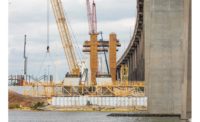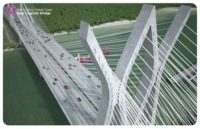Stantec-Jacobs Team Wins $1.9B Corps Levee and Floodwall Project to Protect Texas Coast

The Orange County Coastal Storm Risk Management project features a 26.7-mile-long levee and floodwall system along the coastline near Galveston.
Map courtesy Galveston Coastal Services Joint Venture (Stantec/Jacobs)
Galveston Coastal Services Joint Venture, comprised of Stantec and Jacobs, will design a 26.7-mile-long levee and floodwall system along the Texas coast near Galveston, the U.S. Army Corps of Engineers announced Feb. 6. The eight-year, $1.9 billion construction effort is set to make the area less vulnerable to natural disasters, sea-level rise and subsidence.
Design of the Orange County Coastal Storm Risk Management project is expected to last two years, with construction to start in 2022.
This project, dubbed “Orange,” was authorized under the Sabine Pass to Galveston Bay Study, which was completed by the Corps and the Texas General Land Office in December 2017.
After its authorization, the project received federal funding in 2018 and became the largest of three separately bid projects that fell under the Sabine Pass to Galveston Bay coastal protection effort. It also includes projects in Freeport and Port Arthur, Texas. The three projects received the largest allocation—$3.9 billion—of the $17.4 billion in the 2018 legislation for U.S. disaster recovery funding.
According to the Stantec-Jacobs team, Orange will center on a stretch of the upper Texas coast from Sabine Pass to Galveston Bay, and includes both Gulf of Mexico and bay waters, barrier islands, marshes, coastal wetlands, rivers and streams and adjacent areas that make up the interrelated coastal area.
Over the past 10 years, the area has been altered physically and economically by extreme weather events such as Hurricane Harvey.
The project includes seven design packages for 15.6 miles of new levees, 10.7 miles of new concrete floodwalls and gates, seven new pump stations to manage interior flooding during surge events, 453 acres of marsh restoration, and 560 acres of forested wetlands preserved. The project will also include navigable sector gates.
“Essentially, we are creating a coastal spine that will help protect the Texas coast, providing a solution that not only benefits this area long-term, but the millions of people and businesses in this region that are most impacted by weather,” said Pankaj Duggal, Jacobs senior vice president of federal & environmental solutions.
The project team expects design of the seven packages will take 18 to 24 months. The team also includes 20 local, small business enterprises representing 40% of the design budget.
The Corps expects project completion in 2026.





